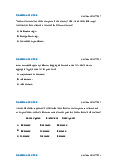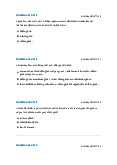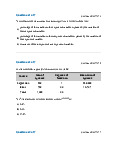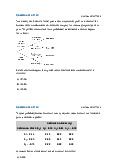













Preview text:
Chapter 6 Writing Introductory Exercises
1. Match each statement in the left column with the most appropriate mode of
communication in the right column, and note why.
1. Need the sales figures for the last A. Text Message or IM month available in three days
2. Inform department employees of B. Email F2F meeting next month
3. International client requests price C. Fax quote 4. Assigned to investigate D. Report
partnership with supplier to co- develop a new product
5. Need to inform employee of a E. Proposal discrepancy in their expense report
6. Need to facilitate meeting with
F. Face to Face (F2F) Meeting, two department managers from Interpersonal Interaction two distinct time zones.
7. Need to follow up with customer
G. Meeting (F2F), Group or Team post sale
8. Need to contact new prospective H. Meeting (Mediated), customer teleconference or videoconference
There are no right or wrong answers to this matching exercise, but there are strengths
and weaknesses associated with each mode. Does the information need to be received
© 2016 Flat World Knowledge, Inc. 1
as soon as possible? Will the document require time and preparation? Will the result
be comprehensive and require visual representation of data, trends, and their
relationships(s)? Associate each statement with what you consider the most appropriate
model of communication and note why. Discuss your responses with your classmates.
2. These sentences focus on some of the most common errors in English. Can you fill in the blanks correctly? 1 “accept” or
The office will _______ applications until 5 PM on the “except” 31st.
Attendance is required for all employees _______ supervisors. 2 “affect” or
To _______ the growth of plants, we can regulate the “effect” water supply.
A lack of water has a predictable _______ on most plants. 3 “e.g.” or “i.e.”
Please order 2,000 imprinted giveaways (_______, pens or
coffee mugs) to and charge them to my account (_______, account #98765). 4 “its” or “it’s”
The department surpassed _______ previous sales record this quarter.
_______ my opinion that we reached peak oil in 2008. 5 “lay” or “lie”
Please _______ the report on the desk.
The doctor asked him to _______ down on the examination table. 6 “pressure” or
We need to _______ the liquid nitrogen tanks. “pressurize”
It might be possible to _______ him to resign. 7 “principle” or
It’s the basic _________ of farming: no water, no food. “principal”
The _______ reason for the trip is to attend the sales meeting. 8 “regardless” or
_______ of what we do, gas prices are unlikely to go back “irregardless” down.
_______ of your beliefs, please try to listen with an open mind. 9 “than” or
This year’s losses were worse _______ last year’s.
© 2016 Flat World Knowledge, Inc. 2 “then”
If we can cut our costs, _______ it might be possible to break even. 10 “that” or
_______ type of marketing data did you need? “which”
Karen misplaced the report, _______ caused a delay in making a decision.
There are several kinds of data _______ could be useful. 11 “there” “their,”
The report is _________, in the top file drawer. or “they’re”
__________ strategic advantage depends on a wide distribution network.
__________ planning to attend the sales meeting in Pittsburgh. 12 “to” “too,” or
Customers need _______ drive slower if they want to save “two” gas.
After sales meeting, you should visit customers in the Pittsburgh area _______.
In fact, the _______ of you should make some customer visits together. 13 “uninterested”
He would be the best person to make a decision, since he or
isn’t biased and is relatively _______ in the outcome. “disinterested”
The sales manager tried to speak dynamically, but the
sales reps were simply _______ in what he had to say. 14 “who,” __________ truck is that? “whom,”
__________ going to pay for the repairs? “who’s,” or
__________ will go to the interview? “whose”
To __________ should we address the thank-you note? 15 “your” or
My office is bigger than _______ cubicle. “you’re”
_______ going to learn how to avoid making these common mistakes in English. Getting Started
© 2016 Flat World Knowledge, Inc. 3
If all the world is a stage then you, as a business writer, must be the scriptwriter,
correct? Actually, those who employ you, specify your job duties, manage the business,
and designate which problems you are to solve are more like the scriptwriters, directors,
and producers. So what role does that leave you as a business writer? Actor. You may
not be seen “on stage” by the suppliers you write, the departments you inform with
your reports, or the customers you serve, but your writing represents you and your
organization. As an actor must learn his or her lines, you too must learn the role of a
business writer within the context of your business or organization. It may well be that
you are allowed a degree of improvisation and creativity when you interpret your role,
or it could be the case that many of the written documents you will produce follow a
standard template, much like a script, that designates your lines before the writing
process begins. Knowing your place on stage and how it relates to your business is an
important aspect of business writing best not ignored.
This chapter focuses on several strategies for success when it comes to the
creative process of writing, and your awareness of these skills will prove invaluable as
your responsibility increases and your ability to shape documents develops. Never lose
sight of the fact that each document exists with a universe of relationships and
interaction; it does not stand alone. Also remember that what you write today,
particularly if you “publish” it on the Internet, will be there for years to come. Always
consider how your words will represent you and your organization when you are not
there to clarify, defend, or correct them. Your audience will have expectations of you, as
will your employer, and as an effective business writer you know that one key to
success is meeting these expectations.
Creative writing for exposition, narration, and self-expression is an important
part of writing, but in the business context you have a role, job duties, and
responsibilities both internal and external to your organization. Your mastery of clear
and concise writing will directly affect the interpretation, and misinterpretation, of your
message. Your goal remains to reduce misunderstandings through the effective and
efficient use of words in business documents, and the well-known mandate to “Omit
needless words” stands true. Up to this point you have been preparing to write, but
now the moment has come for performance.
© 2016 Flat World Knowledge, Inc. 4 1. Organization Learning Objectives
1. Understand how to develop and organize content in patterns that are appropriate for your document and audience.
2. Demonstrate your ability to order, outline, and emphasize main points in one or more written assignments.
3. Demonstrate how to compose logically organized paragraphs, sentences, and
transitions in one or more written assignments. Section Outline 1. Organization
General Purpose and Thesis Statements Organizing Principles Outlines Paragraphs Effective Sentences Transitions Key Takeaway
Organization is the key to clear writing. Organize your document using key elements,
an organizing principle, and an outline. Organize your paragraphs and sentences so that
© 2016 Flat World Knowledge, Inc. 5
your audience can understand them, and use transitions to move from one point to the next. Exercises
1. What functions does organization serve in a document? Can they be positive or
negative? Explain and discuss with a classmate.
2. Create an outline from a sample article or document. Do you notice an organizational
pattern? Explain and discuss with a classmate.
3. Which of the following sentences are good examples of correct and clear business
English? For sentences needing improvement, describe what is wrong and write a
sentence that corrects the problem. Discuss your answers with your classmates.
a. Marlys has been chosen to receive a promotion next month.
b. Because her work is exemplary.
c. At such time as it becomes feasible, it is the intention of our department to
facilitate a lunch meeting to congratulate Marlys
d. As a result of budget allocation analysis and examination of our financial
condition, it is indicated that salary compensation for Marlys can be increased to a limited degree.
e. When will Marlys’s promotion be official? f. I am so envious!
g. Among those receiving promotions, Marlys, Bob, Germaine, Terry, and Akiko.
h. The president asked all those receiving promotions come to the meeting.
i. Please attend a meeting for all employees who will be promoted next month.
j. Marlys intends to use her new position to mentor employees joining the firm,
which will encourage commitment and good work habits.
© 2016 Flat World Knowledge, Inc. 6
4. Find an example of a poor sentence or a spelling or grammar error that was published
online or in print and share your finding with the class. Key Terms 1. Ethos Credibility 2. Logos Logic and reason 3. Pathos Passion and enthusiasm 4. Outline
A framework that organizes main ideas and subordinate ideas in a hierarchical series. 5. Topic sentence
Sentence that states the main thesis, purpose, or subject of the paragraph 6. Body sentences
Sentences that support the topic sentence and relate clearly to the subject matter
of the paragraph and overall document 7. Conclusion sentence
Sentence that brings the paragraph to a close 8. Declarative sentence
Sentence that makes a statement 9. Interrogative sentence
© 2016 Flat World Knowledge, Inc. 7 Sentence that asks a question 10. Imperative sentence
Sentence that conveys a command 11. Exclamatory sentence
Sentence that expresses a strong emotion 12. Transitions
Bridges between ideas, thoughts or concepts; words, phrases, or visual devices
that help the audience follow the speaker’s ideas, connect the main points to
each other, and see the relationships in a speech. 2. Writing Style Learning Objectives
1. Demonstrate your ability to prepare and present information using a writing style that
will increase understanding, retention, and motivation to act. Section Outline 2. Writing Style Formal Versus Informal
Introductions: Direct and Indirect Adding Emphasis Active Versus Passive Voice Commonly Confused Words
Making Errors at the Speed of Light
© 2016 Flat World Knowledge, Inc. 8 Key Takeaway
An appropriate business writing style can be formal or informal, depending on the
context but it should always reflect favorably on the writer and the organization. Exercises
1. Select at least three examples of writing from different kinds of sources, such as a
government Web site, a textbook, a popular magazine, and a novel. According to the
style characteristics discussed in this section, how would you characterize the style of
each? Select a paragraph to rewrite in a different style—for example, if the style is
formal, make it informal; if the selection is written in active voice, make it passive.
Discuss your results with your classmates.
2. What are some qualities of a good business writing style? What makes certain styles
more appropriate for business than others? Discuss your thoughts with a classmate.
3. Find an example of formal writing and write an informal version. Please share with your classmates.
4. Find an example of informal writing and write a formal version. Please share with your classmates.
5. You are assigned to a work team that has to come up with a formal declaration and an
informal explanation for the declaration. The declaration could be a memo indicating
that your business will be observing a holiday (each team should have a different holiday).
© 2016 Flat World Knowledge, Inc. 9
6. How would you characterize your writing style? Do you need to make modifications
to make your style suitable for business writing? Write a one- to two-page essay on this subject. Key Terms 1. Writing style
Also known as voice or tone; the manner in which a writer addresses the reader 2. Conversational tone
Writing style that resembles oral communication 3. Passive voice
Sentence structure in which the subject receives the action 4. Active voice
Sentence structure in which the subject carries out the action 3. Making an Argument Learning Objectives
1. Demonstrate how to form a clear argument with appropriate support to persuade your audience.
2. Recognize and understand inherent weaknesses in fallacies. Section Outline
© 2016 Flat World Knowledge, Inc. 1 3. Making an Argument
Effective Argumentation Strategies: GASCAP/T Evidence Appealing to Emotions Recognizing Fallacies
Ethical Considerations in Persuasion Key Takeaway
The art of argument in writing involves presenting supportive, relevant, effective
evidence for each point and doing it in a respectful and ethical manner. Exercises
1. Select a piece of persuasive writing such as a newspaper op-ed essay, a magazine
article, or a blog post. Examine the argument, the main points, and how the writer
supports them. Which strategies from the foregoing section does the writer use? Does
the writer use any fallacies or violate any ethical principles? Discuss your results with your classmates.
2. Find one slogan or logo that you perceive as persuasive and share it with your classmates.
3. Find an example of a piece of writing that appears to want to be persuasive, but
doesn’t get the job done. Write a brief review and share it with classmates.
4. In what ways might the choice of how to organize a document involve ethics?
Explain your response and discuss it with your class.
© 2016 Flat World Knowledge, Inc. 1 Key Terms 1. Emotion
A psychological and physical reaction, such as fear or anger, to stimuli that we experience as a feeling. 2. Emotional resistance
Occurs when an audience gets tired, often to the point of rejection, of hearing
messages that attempt to elicit an emotional response. 3. Fallacy False logic.
4. Paraphrase and Summary Versus Plagiarism Learning Objectives
1. Understand the difference between paraphrasing or summarizing and plagiarism.
2. Demonstrate how to give proper credit to sources that are quoted verbatim, and
sources whose ideas are paraphrased or summarized.
3. Demonstrate your ability to paraphrase in one or more written assignments. Section Outline
4. Paraphrase and Summary Versus Plagiarism
© 2016 Flat World Knowledge, Inc. 1 Key Takeaway
There is nothing wrong with quoting, paraphrasing, and summarizing with credit to
your original source, but presenting someone else’s work as if it were your own is plagiarism. Exercises
1. Select a piece of writing such as an essay from a Web site, a book chapter, or a
newspaper or magazine article. Write a paraphrase of a portion of it. Write a brief
summary of the entire piece. Note the difference between the two techniques. Giving
credit to the original piece, discuss your paraphrase and summary with your classmates.
2. Find an example of an advertisement you perceive as particularly effective and write
a one-sentence summary. Share the advertisement and your one-sentence summary with the class.
3. Find an example of an advertisement you perceive as particularly ineffective and
write a one-sentence summary. Share the advertisement and your one sentence review with the class.
4. Find a case where plagiarism or misrepresentation had consequences in the business
world. Share your findings and discuss with classmates. Key Terms 1. Verbatim Word for word
© 2016 Flat World Knowledge, Inc. 1 2. Paraphrase
To rewrite information in your own words 3. Summarize
To reduce a concept, idea, or data set to its most basic point or element 4. Plagiarism
Representing another’s work as your own 5. Patch writing
Verbatim cut-and-paste insertion of fragments of other publications into one’s
own writing without crediting the sources.
© 2016 Flat World Knowledge, Inc. 1




